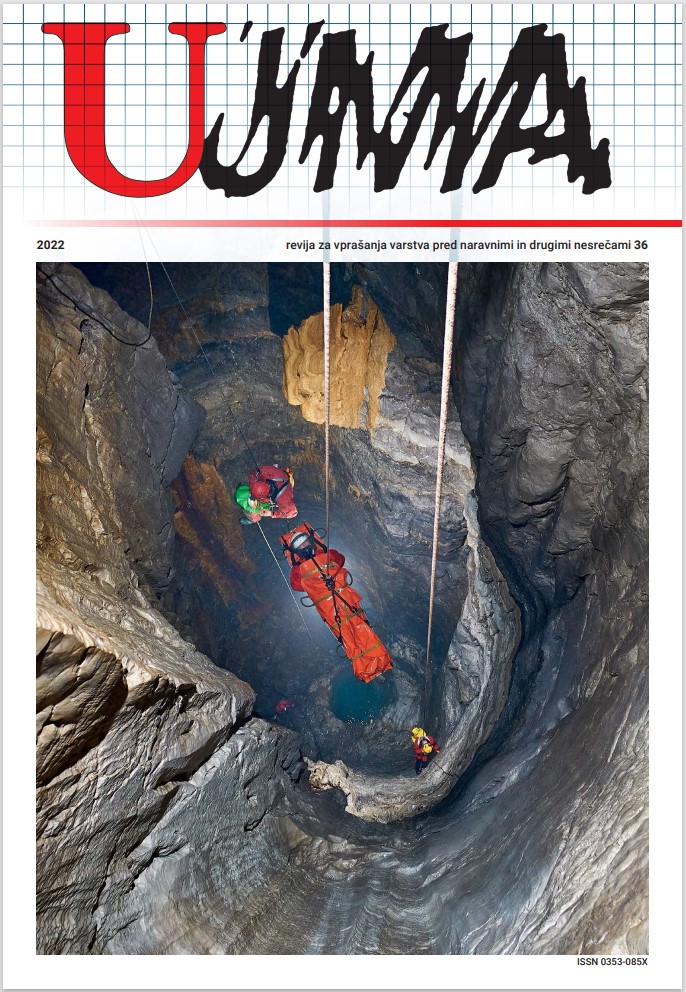ASSESSMENT OF EXTREME PRECIPITATION AND SNOW CONDITIONS IN THE PRESENT AND FUTURE CLIMATE IN THE CROSSBORDER REGION OF SLOVENIA AND AUSTRIA
Abstract
The spatial distribution of extreme precipitation and snow load for parts of Slovenia (the Gorenjska, Koroška, Savinjska, Podravska, Pomurska, Osrednjeslovenska, Goriška and Zasavska regions) and Austria (the states of Styria and Carinthia) was assessed within the framework of the CROSSRISK project. On the Austrian side, the most exposed region for short duration extremes are the lowlands and hilly areas of southern and eastern Styria. On the Slovenian side, even higher return levels are observed, the highest are in the Upper Soča Valley. For longer-term extreme precipitation (on a daily scale), the highest return levels are limited to mountainous areas. The future evolution of extreme precipitation cannot be analyzed in similar detail as the past, since climate models so far lack the ability to adequately represent small-scale convective extremes. However, model simulations show that the maximum daily precipitation could increase by up to 40% by the end of the 21st century. In addition, the total winter-season precipitation is expected to increase considerably in the following decades. The largest snow loads are limited to the hilly and mountainous regions. The plains in the east of both countries stand out as areas of low snow load, mainly due to the small amount of winter precipitation. The future evolution of snow cover has been investigated based on state-of-the-art snow models and an ensemble of regional climate models. An ensemble calculation is a repeated calculation of the forecast with a numerical meteorological model, with each calculation having a slightly modified initial state. This allows us to assess to a certain extent the impact of errors and incomplete knowledge of the initial conditions on the development of the forecast. Regardless of the scenario of greenhouse gas emissions, we can expect a significant decrease in the number of days with snow cover throughout the area in the future, of 20-90% according to different assessments.
References
ARSO, Urad za meteorologijo in hidrologijo, 2019. Začasna izjava Svetovne meteorološke organizacije o stanju podnebja leta 2019. http://meteo.arso.gov.si/uploads/probase/www/climate/text/sl/publications/SMO%20stanje%20podnebja%202019.pdf.
ARSO, Urad za meteorologijo in hidrologijo, 2018. Kaj pomeni 1,5 °C namesto 2 °C toplejše Zemljino površje za Slovenijo? http://meteo.arso.gov.si/uploads/probase/www/climate/text/sl/publications/Kaj%20pomeni%201.5%20stopinje%20za%20Slovenijo.pdf.
Bertalanič, R., in sod., 2018. Ocena podnebnih sprememb v Sloveniji do konca 21. stoletja: sintezno poročilo. Ljubljana: Ministrstvo za okolje in prostor, Agencija Republike Slovenije za okolje.
Chimani, B., Heinrich, G., Hofstätter, M., Kerschbaumer, M., Kienberger, S., Leuprecht, A., Truhetz, H., 2016. ÖKS15 – Klimaszenarien für Österreich. Daten, Methoden und Klimaanalyse (Project Report). Wien: ZAMG.
Coles, S., 2004. An Introduction to Statistical Modelling of Extreme Values. Springer, Bristol, 3rd printing, 47–52.
European Environment Agency, 2021. Mean precipitation. https://www.eea.europa.eu/data-and-maps/indicators/european-precipitation-2/assessment.
Jacob, D., Petersen, J., Eggert, B., in sod., 2014. EURO-CORDEX: new high-resolution climate change projections for European impact research. Reg Environ Change, 14, 563–578.
Koutsoyiannis, D., 2004a. Statistics of extremes and estimation of extreme rainfall: I. Theoretical investigation. Hydrological Science Journal, 49, 575–590.
Koutsoyiannis, D., 2004b. Statistics of extremes and estimation of extreme rainfall: II. Empirical investigation of long rainfall records. Hydrological Science Journal, 49, 591–610.
Kozjek, K., Vertačnik, G., 2020. Časovno in prostorsko glajeni povratni nivoji ekstremnih nalivov. Vetrnica, 12-13(19), 2020, 77–85.
Lokošek, N., Vertačnik, G., 2020. Prostorska interpolacija maksimalne snežne obtežbe. Vetrnica, 12-13(19), 2020, 86–93.
mGROWA Slovenija, 2018. Rezultati modela vodne bilance za Slovenijo. http://meteo.arso.gov.si/met/sl/watercycle/mgrowa-si/.
Papalexiou, S. M., in Koutsoyiannis D., 2013. Battle of extreme value distribution: A global survey on extreme daily rainfall. Water Resources Research, 49, 187–201.
Ragulina, G., in Reitan, T., 2017. Generalized extreme value shape parameter and its nature for extreme precipitation using long time series and the Bayesian approach. Hydrological Sciences Journal, 62, 863–879.
Sanpaolesi, L., 1998. Commision of the European Communities DGIII – D3, Scientific support activity in the field of structural stability of Civil Engineering works, SNOW LOADS, FINAL REPORT, University of Pisa.
Sanpaolesi, L., 1999. Commission of the European Communities, DGIII – D3, Scientific support activity in the field of structural stability of Civil Engineering works, SNOW LOADS, FINAL REPORT, University of Pisa.
Sanpaolesi, L., 1999. Commission of the European Communities, DGIII – D3, Scientific support activity in the field of structural stability of Civil Engineering works, SNOW LOADS, ANNEX B to the final report, EUROPEAN GROUND SNOW LOADS MAP, University of Pisa.
Serinaldi, F., in Kilsby, C. G., 2014. Rainfall extremes: Toward reconciliation after the battle of distributions. Water Resources Research, 50, 336–352.
van Vuuren, D. P., Edmonds, J., Kainuma, M., in sod., 2011. The representative concentration pathways: an overview. Climatic Change, 109. https://doi.org/10.1007/s10584-011-0148-z.
Downloads
Published
Issue
Section
License

This work is licensed under a Creative Commons Attribution-NonCommercial-NoDerivatives 4.0 International License.
The articles are made available to the public under Creative Commons Attribution-NonCommercial-NoDerivatives 4.0 International (CC BY-NC-ND 4.0).


